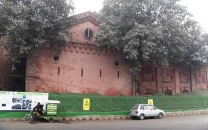Of 'unblossomed flowers' and some woodwork
A kind of stillness usually pervades your works, a silence that shouts

Dear Humaira Abid,
Allow me to begin this letter with a note of condolence; to the families who lost their children to wars, to anyone who could resonate with such pain and to all of us who should not only mourn the children but the dearth of sanity, the debacle of compassion and the death of humanity. I am writing this letter with trembling hands, tears in my eyes and a lump in my throat. It is how strong the message is in 'The Shape of War', the recently installed piece at Greg Kucera Gallery, Seattle. "20 altars of loss," as the installation is described by The Seattle Times, each honouring a child lost in war.
A wooden rehal, a typical book-rest for the Quran, with prayer beads and a tiny flower also carved in wood, set on a small, white school desk, drawer open, revealing pictures, dreams and aspirations of the lost ones. This is a classroom where all the students are absent. They were forced to quit the course of life, leaving a muffled void behind. Those who were immolated for useless wars had the potential to live, grow and contribute to the beauty and splendor of the world. 'The Shape of War' resonates with a poignant memory. My heart goes out to the innocent victims of the Army Public School, Peshawar. Here is a lesson worth learning and remembering. Prayers.
A kind of stillness usually pervades your works, a silence that shouts. To me, it is the medium of wood that makes the carved marks seem arrested in time, lending the works a force that casts a spell on their viewer. Perhaps it is the dichotomy between the message and the medium; the impermanence and temporality of the idea (loss, grief, migration, movement) and the rigidity of wood lend a duality to the forms, amplifying the force of your statement. One impatiently waits for the carved piece of paper to flutter (Letters & Envelopes, 2020) or a folded shirt to rumple (Folded Stories, 2023-24) and in those moments, you are able to capture the mind and imprint your message.
The messages, though personal, have a universal appeal. "Searching for home" may be a story of a woman experiencing marriage-migration or it can be a story of a distressed mother crossing borders; in Syria, Iraq, Gaza, Israel, Ukraine, India or any other warzone where she has to mind the barbed wires and manage survival worrying less about her belongings and other necessities that turn into accessories. And I am referring to the scattered baby shoes and stained garments as emblems of childhood and youth — the notions that lose significance when facing displacement or death.
Wood, abundant in nature, has been one of the first materials that humans learnt to employ for shaping into more useful objects. Early examples include shaped sticks and spears used for hunting animals. Then one finds flint tools that were used to carve wood into vessels, coffins and more complex building structures. Later examples are of carpentry, cabinetry, furniture, wood carving and wood turning, proving it to be a handy material. Today, skilled fine woodworking remains a craft pursued by many, though some contemporary artists find it tedious and impermanent, specially when compared with marble.
On your preference for wood, people notice a kind of clash in your practice — of gender division in opting for the medium that demands more physical strength and your training in miniature painting, which is traditionally about delicacy and refinement. I shall strongly reject such labels for mediums exhibiting a masculine and feminine or aggressive and passive divide in creative expressions.
For the sympathisers of South Asian women who consider us oppressed and mute, here is someone you need to follow. For our women, losing the spirit of catalysts and reagents and turning into papa ki paris, here is someone to idealise and romanticise. Here is someone who is challenging the taboos, celebrating small successes, living the life of a woman, a thinker, a visionary and a spokesperson. After all, it is what art is all about — visiting and revisiting the realities of life, highlighting the wrongdoings, allowing reprimand, agitating, protesting, advocating, mourning, lamenting, but still staying human.
Bano
July, 2025















COMMENTS
Comments are moderated and generally will be posted if they are on-topic and not abusive.
For more information, please see our Comments FAQ